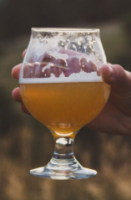Brew Log History
Ambient: {{ stats.ambient | number:0 }} °F
OG: {{ stats.ogGravity | number:3 }}
Attenuation: {{ stats.attenuation | number:2 }}%
Calories: {{ stats.calories | number:1 }} / 12oz
Carbs: {{ stats.carbs | number:1 }} g / 12oz
Readings: {{ readingsCount | number }}
{{ formatHeaderDate(dates.navStart) | date:'mediumDate' }} to {{ formatHeaderDate(dates.navEnd) | date:'mediumDate' }}
Last Updated: {{ stats.lastupdated.ago }} from {{ stats.lastupdated.source }}
Hops
|
Amount
|
Variety
|
Cost
|
Type
|
AA
|
Use
|
Time
|
IBU
|
Bill %
|
|
8 oz |
Galaxy8 oz Galaxy Hops |
|
Pellet |
14.25 |
Hop Stand at 180 °F
|
30 min |
26.33 |
25% |
|
8 oz |
Mosaic8 oz Mosaic Hops |
|
Pellet |
12.5 |
Hop Stand at 180 °F
|
30 min |
23.09 |
25% |
|
8 oz |
Galaxy8 oz Galaxy Hops |
|
Pellet |
14.25 |
Dry Hop
|
7 days |
|
25% |
|
8 oz |
Mosaic8 oz Mosaic Hops |
|
Pellet |
12.5 |
Dry Hop
|
7 days |
|
25% |
|
32 oz
/ $ 0.00
|
Hops Summary
|
Amount
|
Variety
|
Cost
|
IBU
|
Bill %
|
|
16 oz |
Galaxy (Pellet) 15.999999963401 oz Galaxy (Pellet) Hops |
|
26.33 |
50% |
|
16 oz |
Mosaic (Pellet) 15.999999963401 oz Mosaic (Pellet) Hops |
|
23.09 |
50% |
|
32 oz
/ $ 0.00
|
Mash Guidelines
|
Amount
|
Description
|
Type
|
Start Temp
|
Target Temp
|
Time
|
|
10 gal |
|
Infusion |
154 °F |
154 °F |
60 min |
Other Ingredients
|
Amount
|
Name
|
Cost
|
Type
|
Use
|
Time
|
|
2 each |
Whirfloc
|
|
Fining |
Boil |
15 min. |
Priming
|
Method: co2
Amount: 13.9 psi
Temp: 40 °F
CO2 Level: 2.65 Volumes |
Target Water Profile
231 Wash Pond
Notes
New England Style IPA
Notes:
NE-IPA will be judged according to the 21B Specialty IPA guidelines as a distinct Type of Specialty IPA.
As with other Types, Entrant must specify a Strength as session, standard, or double. If unspecified, the entry will be judged as standard strength. The ABV ranges for strengths are the same as for other Specialty IPA’s.
Entrant may specify hop varieties used and/or method of use (e.g. bittering, whirlpool, dry hop), if Entrant feels this information is critical to appreciating the beer. Supplying this information is entirely optional, and doing so may affect judging positively or negatively depending on the judges’ perception of the expected varietal or process-related characteristics.
Impression
A refreshing hop-driven pale ale showcasing fresh, juicy, fruity hop flavors and aromas. Moderate bitterness and low malt flavors only play a supporting role, preserving approachable drinkability. Deceptively soft, creamy mouthfeel gives way to a crisp, dry finish characteristic of all American IPA’s. Singularly hazy but still attractive to those who appreciate an intense hop experience.
Aroma
High to intense fresh hop aromas, emphasizing fruity notes reminiscent of tropical fruits, stone fruits, berries, melons, and citrus fruits. Piney, resinous, or spicy hop aromas should complement the fruity character. The best examples are not grassy or vegetal. Yeast-derived aromas include low to moderate esters that complement the hoppy aromas, and are often also characteristic of tropical and stone fruits. Low to medium-low fresh grainy or crackery malt aromas provide background notes, with little to no caramel or toast. May have a low bready aroma when wheat or other adjunct grains are used. No diacetyl. Stronger versions may exhibit an alcohol note, but should not be solventy or hot.
Appearance
Pale straw to orange in color. Typically quite hazy to nearly opaque–suggesting orange juice–however some beers might clarify as they age, leaving only faint haze. Fluffy and persistent white head, often depositing intricate lacing on the glass.
Flavor
As with aroma, medium-high to intense fresh hop flavors should be in the forefront, with emphasis on tropical fruits, stone fruits, berries, melons, and citrus fruits. Piney, resinous, earthy, and spicy hop flavors should complement the fruity flavors, and grassy or vegetal hop character is absent. Bitterness may be medium-low to medium-high, and should be smooth and never sharp or harsh. Malt flavor is low to medium-low and is typically fresh and grainy, crackery, or bready, with medium-low to very low perceptible sweetness. Overall balance is bitter, but less so than standard American IPA. Low to moderate yeast-derived fruity flavors should complement the hops. Finish should be dry to medium-dry, with long-lingering fruity hop flavors.
Mouthfeel
Soft, smooth mouthfeel with medium-light to medium-full body and moderate carbonation. Low ratios of sulfate to chloride ions can give a distinctly juicy, mouth-watering sensation, while high-protein adjuncts and suspended yeast may provide some creaminess. The finish should be smooth and clean and never astringent. Stronger versions may exhibit some alcoholic warmth, but the strength should be well-hidden.
Comments
NE-IPA’s are best consumed fresh, with delicate hop aromas and flavors falling off quickly, and high amounts of suspended solids potentially causing poor stability. Most classic examples straddle the line between standard and double IPA’s, but with lower bitterness and well-hidden alcohol they have a deceptive drinkability more like standard IPA’s. Bitterness is balanced by a soft, creamy mouthfeel rather than malt sweetness. Hazy appearance may be caused by suspended yeast, hop polyphenols, proteins from adjunct grains, or–rarely–unconverted starches added to the boil. Some of these sources of haze will settle out over time, so a somewhat older beer may be only slightly hazy while a fresh version could be totally opaque. Haziness approaching opacity is a signature of the NE-IPA style, but results from ingredients and processes chosen to provide an intensely enjoyable hop experience. Appearance is not an end in itself for NE-IPA. Most characteristics scale fairly linearly with strength, however hop aromas are often nearly as intense in session-strength NE-IPA’s as in double-strength versions, and even session NE-IPA’s may have a relatively creamy mouthfeel.
Ingredients
Pale or 2-row base malt, typically North American or British, provides a blank canvas for these hop-driven ales. Little to no “character” malts such as kilned or crystal malts are used, however large portions of malted or unmalted wheat, oats, or other adjunct grains may be employed to provide body and creaminess. Stronger versions may include simple sugars to boost fermentability. Hop varieties often include new products of breeding programs that were selected for unique and exotic flavors and aromas and high essential oils. Hop bills may be complex, or may emphasize varietal characteristics of a single cultivar. The bulk of hopping comes later in the brewing process, especially at flameout/whirlpool with protracted hop stands, and dry hopping. First wort hops or bittering charges are small or even nonexistent, while some brewers prefer hop extracts for bittering. Ale yeast strains may be American or English, but produce more esters and are less flocculent than the cleaner yeasts often used for standard American IPA’s. Water profiles often have much lower sulfate-to-chloride ratios than other IPA’s, providing a juicy, mouthwatering impression.
Comparison
Compared to standard American IPA’s, NE-IPA’s emphasize hop flavor and aroma to the near exclusion of all else. Flavors and aromas tend to be fruity and exotic, with less focus on the piney and resinous character that may be found in standard American IPA’s. While the balance is still bitter, overall bitterness tends to be lower, and never has the sharpness of some classic American IPA’s. Malty flavors also take a secondary role with little to no caramel or toast. Yeast character is often more present than in standard American IPA, with esters complementing the fruity hop notes. Color tends to be a bit lighter, and any level of haze is acceptable, though bright clarity is not typical. Mouthfeel is softer, fuller, and creamier than other American ale styles.
Examples
Session: 3.0-5.0% ABV
Lawson’s Finest Liquids Super Session, Night Shift Whirlpool, Treehouse Eureka!
Standard: 5.0-7.5% ABV
The Alchemist Focal Banger, Bissel Brothers The Substance, Fiddlehead IPA, Hill Farmstead Susan, Treehouse Julius, Trillium Congress Street
Double: 7.5%+ ABV
The Alchemist Heady Topper, Grimm Artisanal Tesseract, Lawson’s Finest Liquids Sip of Sunshine, Treehouse King Julius
Vital Statistics
IBU: 35-120
OG: 1.040-1.085
ABV: 3%-10%
FG: 1.008-1.018
SRM: 4-10

Last Updated and Sharing

- Public: Yup, Shared
- Last Updated: 2021-07-06 13:01 UTC
For quick copying and pasting to a text based forum or email.
Click the Download as HTML file button below.
Recipe costs can be adjusted by changing the batch size. They won't be saved but will give you an idea of costs if your final yield was different.
|
Cost $ |
Cost % |
| Fermentables |
$ |
|
Steeping Grains
(Extract Only) |
$ |
|
| Hops |
$ |
|
| Yeast |
$ |
|
| Other |
$ |
|
| Cost Per Barrel |
$ 0.00 |
|
| Cost Per Pint |
$ 0.00 |
|
| Total Cost |
$ 0.00 |
|
Discussion about this recipe:





